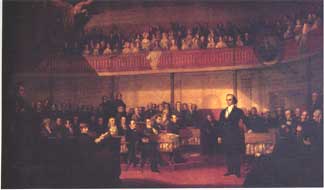1842- Webster Ashburton Treaty

Webster in Congress
This treaty, negotiated by Daniel Webster, the American Secretary of State, and Lord Ashburton resolved the border dispute between the United States and Canada. Canada received 5,000 square miles; and the United States received 7,000. The dispute was primarily on the border of Maine. The disputed issue of the Oregon border was left for later settlement.
The War of 1812 ended without solving any of the border disputes between the United States and British Canada. The disputes between those two countries had existed since the end of the Revolutionary War. The final negotiations were handled by United States Secretary of State Daniel Webster, and a British diplomat, named, Alexander Baring Baron Ashburton.
The first issue they tackled was the location of the border of Maine with New Brunswick. The conflict regarding that border had almost resulted in a shooting war (The Aroostock War.) Ultimately, the Aroostock war was avoided by an agreement for arbitration (which became part of the Webster-Ashburton Treaty.)
The Northern New York State border was the second area regarding which an agreement was reached. The border in Northern New York State was moved ¾ of a mile North, to include an American fort that had inadvertently been built in Canadian Territory.
Finally, the border along the Great Lakes was adjusted. The treaty ended most of the disagreements between the United States.
 >
>